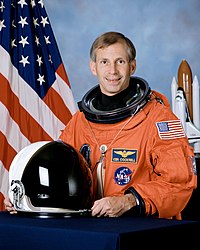Kenneth Cockrell
| Kenneth Cockrell | |
|---|---|

|
|
| Country: | United States |
| Organization: | NASA |
| selected on | Jan 17, 1990 ( 13th NASA Group ) |
| Calls: | 5 space flights |
| Start of the first space flight: |
April 8, 1993 |
| Landing of the last space flight: |
June 19, 2002 |
| Time in space: | 64d 12h 25m |
| retired on | February 2006 |
| Space flights | |
Kenneth Dale "Taco" Cockrell (born April 9, 1950 in Austin , Texas , USA ) is a former American astronaut .
Life
Born in the capital of the US state Texas, Cockrell grew up in the nearby town of Rockdale. In 1968 he graduated from high school and initially studied mechanical engineering at the University of Texas . After his bachelor's degree , which he obtained in 1972, he went to the University of West Florida , where he majored in aeronautical engineering and received a master's degree in 1974 . Cockrell joined the US Navy and was transferred from 1975 for three years as a naval pilot on the A-7 "Corsair II" to the now decommissioned aircraft carrier " USS Midway ", whose route led into the Indian Ocean and the Western Pacific . After returning to the United States, Ken attended the United States Naval Test Pilot School in Patuxent River, Maryland . After completing his training in 1979, he stayed there as a test pilot until the summer of 1982. He then worked for several years as a staff officer for the commanders of the combat units on the " USS Ranger " and the " USS Kitty Hawk ". In 1985 he was used again as a pilot ( F / A-18 "Hornet" ) and undertook two missions on the "USS Constellation" as a member of a combat squadron.
In 1987, Cockrell retired from active military service and in November of that year accepted an aerospace engineer and test pilot position at the Johnson Space Center (JSC) in Houston . Until July 1990 he trained the astronauts on the T-38 “Talon” training machines, flew representatives of NASA management back and forth, or collected air samples from the upper atmosphere for research purposes.
Astronaut activity
Cockrell was introduced with the 13th group of the NASA Astronaut Corps in January 1990 as a pilot candidate for the space shuttle . Basic training began in July 1990 and lasted twelve months.
Just two years after his selection, Cockrell was assigned his first flight in the spring of 1992: STS-56 , aka ATLAS-2, took place in April 1993. The nine-day company researched the interplay between the sun and the earth's atmosphere. Cockrell officially only served as a mission specialist on this flight (although he was a trained pilot). The five-person crew worked in two shifts to ensure maximum utilization of the scientific experiments. The commander and pilot were combined in the blue team with mission specialist Ochoa, while Cockrell and his colleague Foale formed the red team. Any necessary course corrections must be made by a shuttle pilot, so Cockrell was the “third pilot” in front of his team. In September 1995, Cockrell, who is called "Taco" by his fellow astronauts, undertook his second space flight as a pilot of STS-69 . In the hold was the so-called Wake Shield Facility (WSF), which was supposed to produce new semiconductor materials during its three-day free flight. In addition, the astronomy platform SPARTAN-201 was suspended for two days, which primarily examined the solar wind .
Just four months later, Cockrell was nominated as commander of STS-80 . On the last flight in 1996, the WSF was used for the third time. In addition, the ORFEUS-SPAS astronomy platform from Germany was deployed and recaptured towards the end of the flight. In contrast, two planned space exits could not be carried out due to technical problems. Cockrell then worked as head of the astronauts office until he began training for his fourth flight in the fall of 1998. STS-98 served to expand the International Space Station (ISS) and expanded it in February 2001 with the US module Destiny .
A quarter of a year later, Cockrell was given his next mission. STS-111 was also a flight to the ISS that was conducted in June 2002. During the two weeks in orbit, three exits were made and the ISS guard was replaced.
Cockrell spent 2003 in Russia . He worked as a liaison officer in the "Star City" not far from Moscow and coordinated the Russian-American ISS activities. He then worked as deputy head of the aircraft division of the JSC until he was appointed research pilot in the spring of 2006. He heads NASA's high-altitude research program, which uses two WB-57 aircraft to study the Earth's upper atmosphere from the JSC (Ellington Field) airfield .
Ken Cockrell is divorced and has two children with ex-wife Joan, daughter Madeline and son Nathaniel.
See also
Web links
- Short biography of Kenneth Cockrell at spacefacts.de
- NASA biography of Kenneth Cockrell (English; PDF)
- Biography of Kenneth Cockrell in the Encyclopedia Astronautica (English)
| personal data | |
|---|---|
| SURNAME | Cockrell, Kenneth |
| ALTERNATIVE NAMES | Cockrell, Kenneth Dale; Cockrell, Taco (nickname) |
| BRIEF DESCRIPTION | American astronaut |
| DATE OF BIRTH | April 9, 1950 |
| PLACE OF BIRTH | Austin , Texas , USA |